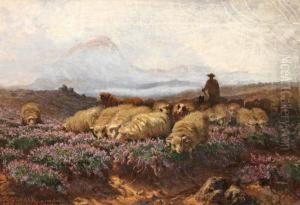Auguste Schenk Paintings
August Friedrich Albrecht Schenk was a Swiss-born painter who became famous for his depictions of animal subjects, particularly sheep amidst snowy landscapes. Born in Glarus, Switzerland, in 1835, Schenk showed an affinity for the arts at an early age. His passion for painting led him to pursue a formal education in the arts. He studied in Paris under the tutelage of Charles Gleyre, a Swiss artist who was known for his influence on the young impressionists. Schenk's time in Paris was formative, as he became immersed in the vibrant artistic community and was exposed to the various movements and styles that were developing during the mid-19th century.
Schenk's career blossomed in France, where he exhibited his works at the Paris Salon, an official art exhibition of the Académie des Beaux-Arts. His most recognized work, 'Anguish' (also known as 'L'Angélus du Matin'), which depicts a ewe mourning the death of her lamb in a snow-covered landscape, was exhibited at the Salon in 1878 and brought him significant acclaim. The emotional resonance of this painting, with its themes of motherhood and loss, touched the hearts of viewers and critics alike. Schenk's ability to capture the tender relationship between animals and the harsh realities they face in nature became a hallmark of his work.
Over the years, Schenk's reputation grew, and his paintings started to be collected by art enthusiasts across Europe. He was particularly noted for his skill in rendering the textures of animal fur and the intricate play of light and shadow in his landscapes. Although he was based in France for much of his career, his subjects often reflected the pastoral and alpine scenes of his Swiss homeland, suggesting a nostalgic connection to his birthplace.
Auguste Schenk lived through the latter part of the 19th century, a period that saw significant changes in the art world, including the rise of Impressionism and Post-Impressionism. However, he remained true to his style, which was rooted in a more traditional academic approach. Despite the transformations happening around him, Schenk's works continued to resonate with audiences who appreciated his romantic and sentimental portrayal of animal life and nature.
Schenk passed away in 1910, leaving behind a legacy of artwork that continues to be appreciated for its emotional depth and technical mastery. His paintings can still be found in museum collections and are studied for their contribution to 19th-century animal painting, a genre that offered a unique window into the human condition through the depiction of the natural world.
